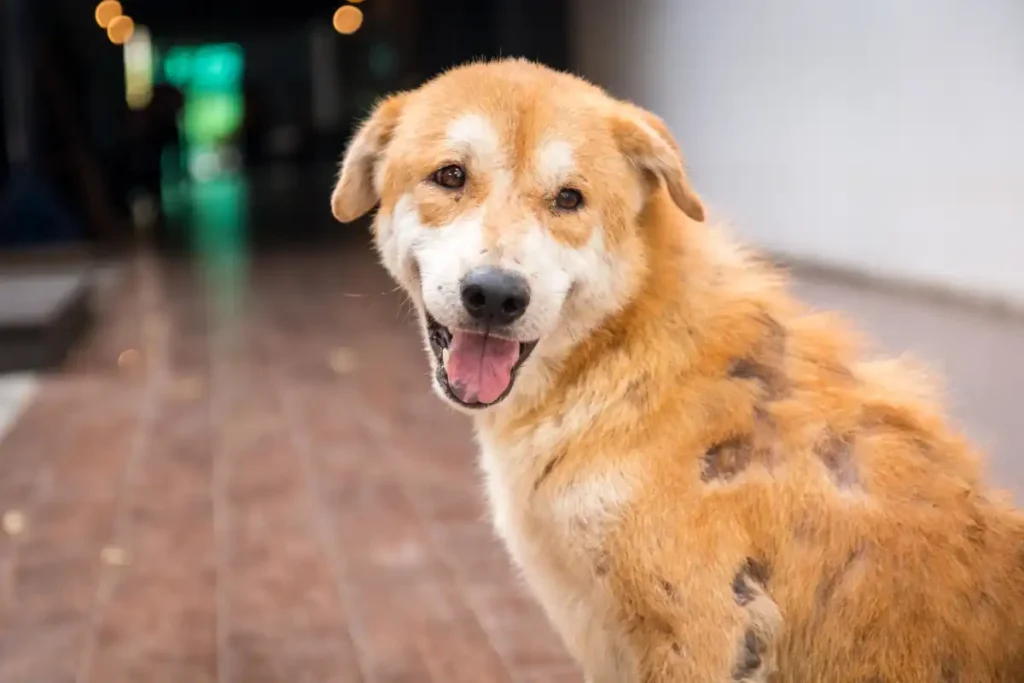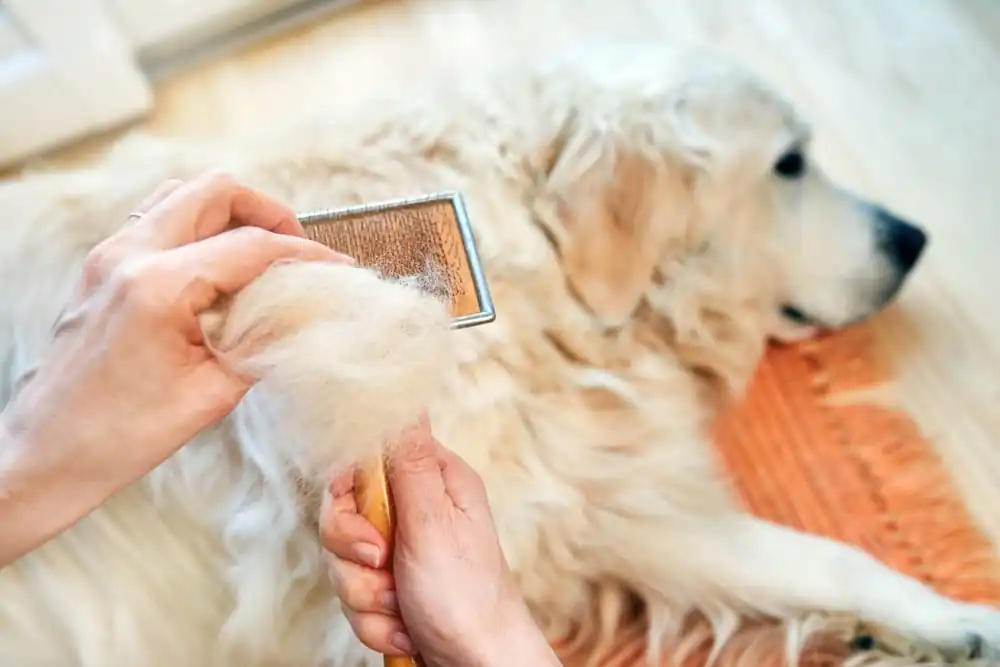Foreword

A thick, shiny coat is a good indicator of a dog’s nutrition, environment and lifestyle, while shedding can be worrying and sometimes difficult to determine why it is occurring.
Symptoms of Hair Loss in Dogs
Symptoms of hair loss may include brittle or dry hair, more hair loss than usual, and the discovery of round or irregularly shaped bald patches. There may also be a concentration of hair loss in a specific area, or hair loss may occur all over the body.
Common Causes of Hair Loss in Dogs

1️⃣: Hair loss in dogs is often caused by parasites such as mites, lice or fleas. This is especially true if the dog is losing hair on the neck and tail, which is most likely due to the presence of fleas. These tiny parasites can quickly proliferate on a dog’s body and cause skin irritation, resulting in the dog wanting to scratch vigorously, causing the skin to lose hair.
2️⃣: Any skin condition, including eczema or dandruff, can eventually lead to hair loss. If a dog is uncomfortable, or if the skin is causing discomfort, the dog will want to scratch, lick and itch to relieve the condition. Over time, this can lead to weakening of specific areas of the skin, loosening of the coat and loss of hair.
3️⃣: Nutritional deficiencies can also cause hair loss, and with adequate nutrition, the skin and coat will develop healthily. Keratin, a core component of the coat, needs to be properly synthesized through thiamine-containing amino acids, without which your dog’s coat may grow slower and be weaker, ultimately leading to hair loss. Similarly, biotin is an important nutrient that helps maintain healthy skin and coat and prevents conditions such as hair loss.
4️⃣: If your dog is shedding, it may also indicate a more complex health problem. Ovarian or testicular tumors can cause localized hair loss, especially in older dogs. Tumors secrete hormones that disrupt the natural reproductive cycle and interfere with healthy hair growth.
5️⃣: Cushing’s disease, a common problem in dogs, can also cause hair loss. The growth of a tumor here causes the dog’s adrenal glands to produce too much cortisol, which in turn leads to obesity, hair loss, dark spots, and several other behavioral symptoms. Another condition is hypothyroidism, which can be a symptom of hair loss when a dog’s hormone production is not as high as it should be.
How to prevent hair loss
Some of the more complex causes of hair loss, such as Cushing’s disease, must be treated and closely monitored by a veterinarian. However, you can help your pet prevent hair loss at home:
✨ Follow the recommended guidelines for regular and effective treatment against fleas and eggs.
✨ Bathe your dog with a dermatologist-approved shampoo to relieve any itchiness and reduce scratching behavior.
✨ Prepare a nutrient-rich diet for your dog to support healthy skin and coat development, including biotin and high-quality, easily digestible proteins.
If you notice any signs of hair loss, it is important to take your dog to your veterinarian for a thorough examination and proper treatment. You can always consult your veterinarian for advice on how to care for your dog’s skin and fur.
I believe that every parent is no stranger to dog hair loss. Whenever spring and fall seasons change, the furry children will become ferocious hair loss monsters, and all the sofas, floors, and clothes in the house will be covered with shedding hairs. Although the dog hair loss is really not a disease, but also can not be ignored pathological hair loss, let’s take a look at the annoying hairy children abnormal hair loss in the end how to do? What kind of hair loss is a sign of disease? What kind of hair loss is a sign of disease and needs medical attention?
In addition to the change of seasons, the normal change of hair of the hairy child, the cause of hair loss of the hairy child is: skin nourishing.
Common causes of itchy skin in hairy children:

In rational hair loss, the hair itself will not feel very itchy skin, but the owner can clearly see the redness and swelling of the skin in the area of hair loss through observation, which means that the hair loss is caused by inflammation of the skin. Common pathologic causes include autoimmune diseases, folliculitis, sebaceous adenitis, psoriasis, pyoderma, and follicular worms. In most cases, the hair loss is asymmetrical and the surrounding hairs become easy to fall off.
Hair Growth Circle Condition
Mammalian hair growth is divided into three phases: the growth phase, the resting phase, and the transition phase.
For animals such as humans, who lose their hair every day, and poodles, which have extra hair and are particularly thick, the growth phase is dominated by the resting phase. But most of the dogs and cats are in the resting phase, the hair grows to a certain length will enter the resting phase, so the short-haired Chihuahua will not become a long-haired Chihuahua for life.
Developmental abnormalities: no hair growth even during the growth period
Usually congenital, such as hair follicle dysplasia, thinning hair syndrome, pigmentation thinning hair syndrome, etc. Most commonly found in Chinese Crested Coats or Sphynx cats, which have already had thin hair.
It is most common in Chinese Crested Dogs or Sphinx cats, which are already hairless, and usually develops within 3 years after birth.
Abnormal hair growth cycle: no resumption of the growth phase after entering the resting phase
More common, the symptoms are extensive hair loss, while the head and limbs are usually normal.
Common disorders such as Alopecia X, shaved areas that no longer produce hair, etc.
“X” means unexplained or untraceable, rare.
Hair follicle dysplasia, thinning hair syndrome, pigmentation thinning hair syndrome, etc. Usually congenital, common in Chinese Crested Dogs, Sphinx cats and other hairy children who already have thin hair.
Endocrine Abnormalities: Hair Loss with Various Symptoms
If you encounter widespread, symmetrical hair loss, darkening of the skin at the point of hair loss, baldness of the hairy child’s nose and tail, changes in appetite, excessive thirst and urination, thinning of the skin, abdominal swelling, or any other symptom, you need to pay special attention to the potential risk of endocrine disease!
The most common ones are hyperadrenalism, hypothyroidism, and estrogen toxicity due to testicular tumors in male dogs and cats with unsterilized or undescended testicles.
If there is an endocrine imbalance, the hair loss will not just look bald, but may deteriorate into serious electrolyte imbalance, dehydration and other life-threatening symptoms.
Therefore, if you find that your furry child suddenly loses hair to the point where his body is bald, especially if it is a large, symmetrical hair loss, it is better to consult a doctor as soon as possible!
Steps in diagnosing the cause of baldness
At the outpatient clinic, the doctor will make a rough assessment of the possible causes based on the distribution of hair loss and whether the hairy child has been chewing on the skin.
If parasites or microbial infections are suspected, skin samples may be taken and cultured to check for pathogens. Sometimes a small piece of skin may be removed for histopathologic examination to confirm inflammation.
If an endocrine disorder is suspected, blood tests, blood biochemistry, urinalysis, and specific hormone levels will be performed to identify the underlying fatal disease. If dietary or environmental sensitivities are suspected, blood allergen testing may also be performed to improve recurrent hair loss symptoms. In middle-aged and older hairy children, tumor screening, such as X-rays, ultrasounds, and other imaging tests, may be recommended.
Usually, if the condition is simply an inflammation or infection of the skin, identifying the cause of the problem can be effective in improving hair loss, such as using special baths, oral antibiotics, or administering ectoparasite drops. However, if the hair follicle is damaged, it is possible that the hair will not grow back for the rest of your life.
Lost hair, can you get it back?
Dogs with double coats or breeds native to frigid regions may experience a large symmetrical loss of hair like an endocrine disease, but are actually in good health; or they may shave in the summer and then not grow any new hair until the winter, or the following spring.
This kind of condition is known as “Alopecia Areata” (X-alopecia) where everything is fine but no hair grows or is lost for no reason. It is more common in Alaskan Shelties, Satsumas, Poodles, Yorkshires, Muffins, Pomeranians, and other dogs that look particularly furry.
Although it looks strange, this disease is only strange, but it is not life-threatening, so it is not treated with medication, and in some cases, the hair will grow back in another spring or fall. So, if you really mind, just put on a cute coat for the winter!
The fluffy and cute Schnauzer is one of the dog breeds that often suffer from “X-Shedding”.
Is hairless skin more fragile?
Some parents may be concerned about the fragility of the hairless areas. In fact, as long as there are no wounds, the skin will still have the same protective function as normal skin and will not be particularly vulnerable to infections just because it is hairless. However, it is important to note that if hair loss occurs due to an endocrine disorder, the skin may become thinner. Therefore, early treatment of the underlying disease is still the key to treatment.
Summary
In conclusion, because the body baldness is very easy to detect, so unless the underlying disease is deteriorating too quickly, or rarely delayed treatment of the situation. Where hairy baby hair loss, do not rush to wipe the medicine, take supplements, after all, hair loss is due to many reasons, other people’s successful treatment may not be suitable for their own baby.
